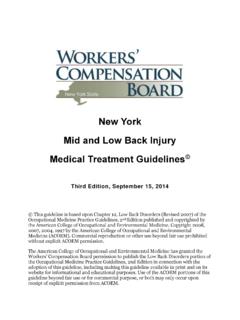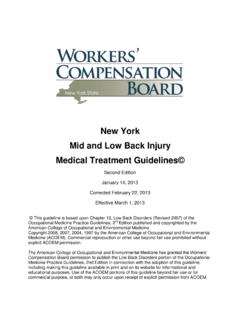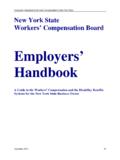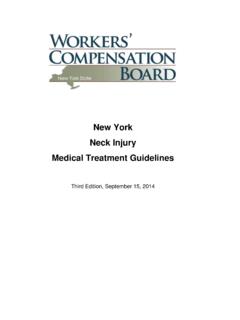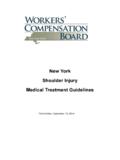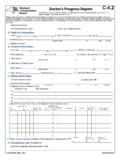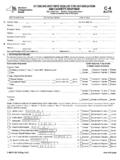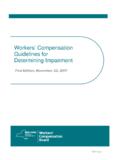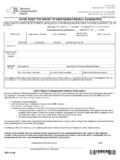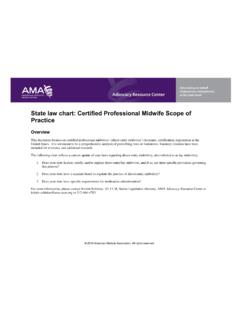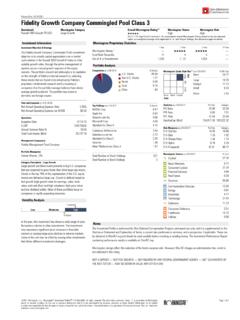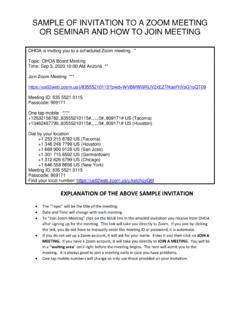Transcription of Special Bulletin 222C Workers’ Compensation Actuarial ...
1 New York State Workers Compensation BoardMarch 2012 Andrew M. Cuomo, GovernorRobert E. Beloten, ChairSpecial Bulletin 222c Workers CompensationActuarial Tables for Aggregate Trust Fund Deposits5% Interest i Foreword The revised tables in this Bulletin apply only to Compensation cases where the accident occurred on or after January 1, 2001. The earlier tables in the 1983 Special Bulletin 222B apply to cases where the accident occurred prior to January 1, 2001. Chapter 6 of the Laws of 2007 amended Workers Compensation Law 27 to change the discount rate applicable to new deposits into the Aggregate Trust Fund on claims made after July 1, 2007, involving accidents or deaths occurring on or after January 1, 2001. The rate changed from the 6% rate applicable to prior accident dates to an industry standard rate to be determined by a regulation promulgated by the Superintendent of Financial Services. Regulation No. 119 adopting 11 NYCRR 151-2.
2 2 set the industry standard rate at 5%. These tables were approved by an Actuarial advisory committee that included Reuben Epstein of the New York State Insurance Fund and Martin Heagen and Ziv Kimmel of the New York Compensation Insurance Rating Board. On behalf of the New York State Workers Compensation Board, I wish to take this opportunity to express my appreciation to these individuals and their staffs for their efforts in preparing these tables. Robert E. Beloten, Chair New York State Workers' Compensation Board Section Page explanation and Examples Example 1: Death Case Award to Widow or Widower and One Child 2 Example 2: Death Case Award to Widow or Widower and Six Children 3 Example 3: Schedule Disability Case 4 Example 4: Permanent Partial Non-Schedule Disability Case 5 Example 5: Interest Due on Award Affirmed on Appeal 6 Example 6: Death Case Award to Orphan Children 7 Example 7: Death Case Award to Brothers, Sisters and Grandchildren 8 Example 8: Death Case Third Party Recovery Award to Widow and No Children 9 Example 9: Social Security Offset with a Widow and No Children 10 Example 10: Deposit of a Capped PPD into the ATF 11 Example 11.
3 Refund of a Capped PPD Deposit from the ATF 12 Tables Survivorship Annuitants Table of Mortality 13 Combined Death and Remarriage Table of the Dutch Royal Insurance Institution 15 Table I Widow or Widower Where There are No Children 17 Table I-A Reduction from Table I Due to Youngest Child 18 Table I-B Reduction from Table I Due to Second Youngest Child 20 Table I-C Reduction from Table I Due to Third Youngest Child 22 Table I-D Reduction from Table I Due to Fourth Youngest Child 24 Table IV Youngest Child 26 Table V Second Youngest Child 28 Table VI Third Youngest Child 30 Table VII Fourth Youngest Child 32 Table VIII Fifth Youngest Child 34 Table IX Children at 66 2/3% 36 Table IX-A Brothers, Sisters and Grandchildren at 25% 37 Table IX-B Children with Widow Remarried 38 Table X Parent or Grandparent 39 Table XI Life Awards 40 Table XII Present Value of $1 per Annum for Duration Given 41 Table XIII Present Value of an Annuity Certain of $1 per Week 59 Table XIV Suspension of 66 2/3% Payments to Children, No Widow 62 Table XIV-A Suspension of 25% Payments to Brothers, Sisters and Grandchildren 63 Table XIV-B Suspension of 30% Payments to Children with Widow Remarried 64 Table XV Suspension of Payments to Widow and No Children 65 Formulae for Workers Compensation Tables Special Bulletin 222c 75 1 WORKERS' Compensation EXAMPLES Example No.
4 1 Death Case Award to Widow or Widower and One Child To find the value as of 1-28-11 of an award to a widow or widower and one child with birth dates as given below where the injured employee had received annual wages of $60,000, was killed 9-1-10, and Compensation benefits had been paid regularly to the dependents to 1-28-11. Dependents Date of Birth Nearest Age Nearest Age Widow .. 5-22-71 39 40 Child .. 1-5-00 11 12 From Table Value as of 9-1-10 Value as of 9-1-11 1 Year Decrease Widow s Portion of Benefit: Widow without children I $ $ Less: Reduction a/c youngest child I-A Widow s Portion Child s Portion of Benefit IV Total Tabular Value to Widow and 1 Child *Less: Decrease to 1-28-11 149/365 X ( ) Tabular Value 1-28-11 Multiply by Number of $100 Annual Wages** Present Value of Future Payments as of 1-28-11** $536, * Increase to 1-28-11: From 9-1-10 to 1-28-11 is 149 days.
5 Since the decrease from 9-1-10 to 9-1-11 is $ , the decrease for 149/365 of a year is $ ** Reduced to $ since the maximum weekly wage base from 7/1/2010- 6/30/2011 was $1, ** Subject to Social Security offset if applicable. 2 WORKERS' Compensation EXAMPLES Example No. 2 Death Case Award to Widow or Widower and Six Children To find the present value as of the date of death of the injured employee of an award to a widow and six children with birth dates as given below where the employee was killed 7-1-09 and received annual wages of $40,000. Dependents Date of Birth Nearest Age Widow 9-7-76 33 Youngest Child 2-6-07 2 2nd Youngest Child 11-11-04 5 3rd Youngest Child 4-27-03 6 4th Youngest Child 3-11-02 7 5th Youngest Child 7-13-99 10 6th Youngest Child 1-21-97 12 From Table Value Value Widow s Portion of Benefit as of 7-1-09: Widow without Children I $ Less: Reduction a/c Youngest Child I-A $ Reduction a/c 2nd Youngest Child I-B Reduction a/c 3rd Youngest Child I-C.
6 41 Reduction a/c 4th Youngest Child I-D .02 Reduction a/c 5th and 6th Youngest Children (Values always zero) Total Reduction Widow s Portion Children s Portion of Benefits as of 7-1-09: Youngest Child IV $ 2nd Youngest Child V 3rd Youngest Child VI 4th Youngest Child VII 5th Youngest Child VIII 6th Youngest Child (Values always zero) Total Children s Portion $ Total Tabular Value to Widow and Four Children $1, Present Value of Death Benefits as of 7-1-09: Total Tabular Value multiplied by number of $100 of Compensable Annual Wages (1, x 400)* $410, *Subject to Social Security offset, if applicable. 3 WORKERS' Compensation EXAMPLES Example No. 3 Schedule Disability Case A married employee lost his arm 11-15-09 and was given an award of $600 per week for 312 weeks from that date. Compensation was regularly paid to 4-18-10, on which date an advance lump sum award of $30,000 was made.
7 What is the effect of this award by the following plans? (a) Payments can be suspended for how many weeks? (b) Weekly Compensation rate can be reduced to what amount? (c) Payments will terminate on what date if this amount is deducted from the end of the award? From Table XXIV it is found that 22 weeks have been paid to 4-18-10 so that on that date 290 weeks remain unpaid. Plan (a): T o determine the suspension period, we will convert the lump sum into a result which we will then compare to the present value of a $1 weekly benefit rate from Table XIII through interpolation. In order to convert, take the lump sum and divide it by the weekly benefit rate and then interpolate the suspension time by using the closest present values to your result. In this case, take the $30,000 lump sum and divide it by $ 600 per week to get a result of $50 at $1 per week. From Table XIII, $50 lies between the present value for 51 weeks and the present value for 52 weeks.
8 From Table XIII, the present value for 51 weeks .. From Table XIII, the present value for 52 weeks .. Increase for 1 The present value for unknown number of weeks .. The present value for weeks .. Difference = Payments should therefore be suspended for weeks from 4-18-10 (=51 weeks + .23 weeks). Plan (b): From Table XIII, the present value of the remaining 290 weeks is X $600 or $152, Of this amount $30,000 or of the present value was reduced by the lump sum award. All future payments may therefore be reduced by X $ 600 or by $ so that $ is the new weekly rate. Plan (c): As in Plan (b) the present value of the 290 weeks remaining is found to be $152, Of this amount $30,000 is now paid so that the remaining present value is $122, at $600 per week or $ at $1 per week. From Table XIII, $ lies between the present value for 226 weeks and the present value for 227 weeks.
9 From Table XIII, the present value for 226 weeks .. From Table XIII, the present value for 227 weeks .. Increase for 1 week .. The present value for unknown number of weeks .. The present value for 226 weeks .. Difference = Payments will therefore terminate 226 weeks after 4-18-10 on 8-24-14 with a final additional payment of $ representing weeks. 4 WORKERS' Compensation EXAMPLES Example No. 4 Permanent Partial Non-Schedule Disability Case To find the present value on 6-15-07 of a life award of $400 per week made to an employee born 8-13-80 if payments had been made to 6-15-07. From Table XI the tabular value at age 27 for each $1 of annual Compensation is The annual Compensation benefit is 52 X $400 or $20,800. The present value of annual Compensation benefits is therefore $20,800 X or $348, (Note. - This method is sufficiently accurate for reserve purposes.)
10 If an exact value is needed such as for purposes of a lump sum settlement, an interpolation must be made between anniversary dates of the accident. A similar interpolation for a fatal case is illustrated in Example No. 1.) 5 WORKERS' Compensation EXAMPLES Example No. 5 Interest Due on Award Affirmed on Appeal Calculate the amount of interest due on an award in the following situation: The WCB judge granted a claimant on 4- 22-11 an award of 40 percent loss of use of arm ( weeks beginning with the date of injury, 7-7-10) at $ per week. The insurance carrier, deciding to continue to controvert the case, appealed the 4-22-11 decision and opted not to pay anything. On 11-1-11 the court confirmed the 4-22-11 award and directed the insurance carrier to make payments from 7-7-10 to 11-1-11 plus interest. The total amount of interest due in the above case is determined by two separate calculations: (1) Calculation of the amount of interest for the period 4-22-11 (date of award) to 11-1-11 (date of payment) on the amount of Compensation benefits which were due and unpaid for the period 7-7-10 (date of injury) to 4-22-11 (date of award); and (2) Calculation of the amount of interest on Compensation benefits payable in periodic installments during the period 4-22-11 (date of award) to 11-1-11 (date of payment).
